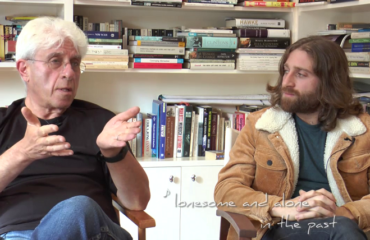In the ancient Chinese legend, the god Huxi fell in love with the fairy Xuanen, and they sprinkled flowers on the river to honour their love. The flowers sank to the bottom of the river and fused into stones and became stone flowers.
“I was 16 years old when I first heard this legend, and this story started my infatuation with stones,” said Bei Shenghua, a stone flower sculptor in Liuyang.
Bei stared as an apprentice stone carver on New Year’s Day, 1991, but it was four years before he was allowed to begin carving.

Bei Shenghua is carving flowers on a stone.
It is the tradition of stone flower carving that every apprentice undergoes extensive training with a master carver. During his four-year apprenticeship the master did not guide Bei in any carving skills, but left him to assist with trivial things like cleaning so he could understand the master’s skills and prepare to carve his first stone flower by himself.
“I dislike discussing my story. What I can only share with you are stones, those gorgeous, extraordinary and intoxicating artworks,” he said.
Chen Jiwu, president of Liuyang Stone Flower Industry Association, said the ancient art of carving stone flowers takes decades to master.
“Both Shenghua and I have been doing this sort of work for over 30 years,” Mr Chen said.
“An apprenticeship of more than a decade sounds quaint in this age, especially for young people but it’s important to document this ancient craft.”

One of Chen Jiwu’s stone flowers in full bloom.
The history of stone flowers in Liuyang
Stone flowers originated around 300 years ago, during the Qing dynasty. The local villagers were surprised to find flowers in the stones they used to build a dam. Several local stonemasons carved those stones into stone flowers, which became sought-after artworks, collected by the imperial courts, officials and wealthy people.
According to Liuyang County Annals, in 1915, Dai Qingsheng, a stone flower master, won the gold prize at the Panama International Exhibition with his works the Yingxue vase and the Mei, Lan, Ju and Zhu screen.
In 1959, Shijusen Mountain, a giant stone flower, was placed in the Great Hall of the People, the congress in Beijing.
In 1997 and 1999, a stone flower was chosen as one of the nation gifts in the handover of Hong Kong and Macao.
After 2000 years, few young people are willing to learn the carving skills required to create stone flowers. Learning the craft requires many years of study and the income is low.
The Hujiaping Workshop in Liuyang is famous for its stone flowers sculptures.
The process of producing one of these famed stone flowers is documented in the photo essay below.
The first stage: choosing stones

“You just mentioned the creator of humankind Nüwa in our mythology, and she shaped us with yellow clay in the ancient story. Personally, carving those stones are not less significant than our creator,” said Bei Shenghua.
“Could you imagine that there were some stone flowers, the national gifts for the handover of Hong Kong and Macao, were just from several ordinary rocks,” he said in his workshop, a 200-square-metre shed with no walls and numerous unfinished stone flowers.

“When we choose, there are some stones with unique natural textures, and together they normally account for less than five per cent of quarry’s stones. Flowers can only be carved on those distinctive stones,” said Bu Youliang, an assistance sculptor.

“Look at this stone, can any artist create the untamed beauty like nature itself? Some collectors adore this natural beauty,” said Bu Youliang.
‘Embryo’ shape: sculpting

Bu Youliang is sculpting a stone, with an electric fan working nearby. He wears a mask because there is a lot of dust involved in stone carving.

The carving gun causes a lot of noise when Bu Youliang sculpts the stone surface. He needs to stop regularly to wash away the dust created by the sculpting.
Blooming

Bei Shenghua engraves the core flower according to the stone’s texture, lines, colour and lustre. He said this step decides the work outcome because the core flower was as important as a diamond glittered on a ring.

Left: a tomb of stone flowers, including defective stones, unsuccessful blooming stones, and unsatisfactory flowers.

Right: A stone flower in full bloom, surrounded by budding chrysanthemums and rosa Chinensis.
Colouring

“I enjoy the accompaniment of podcasts when colouring. People always need to hear someone’s voice, especially while they work alone from dawn to dusk. Youliang and I talk too little at work due to my obsession with carving,” said Bei Shenghua, as he coloured stone flowers with a colouring pen.
Final Carving

“I cannot listen to the radio at this stage. A podcast will distract me, and any mistakes may turn perfection into failure,” said Bei Shenghua before starting the final carving.

Finishing the final carving with a smooth file pen and a brush. It takes Bei Shenghua several weeks or even months to finish one piece, depending on the size of the stone and the complexity of the flowers.





